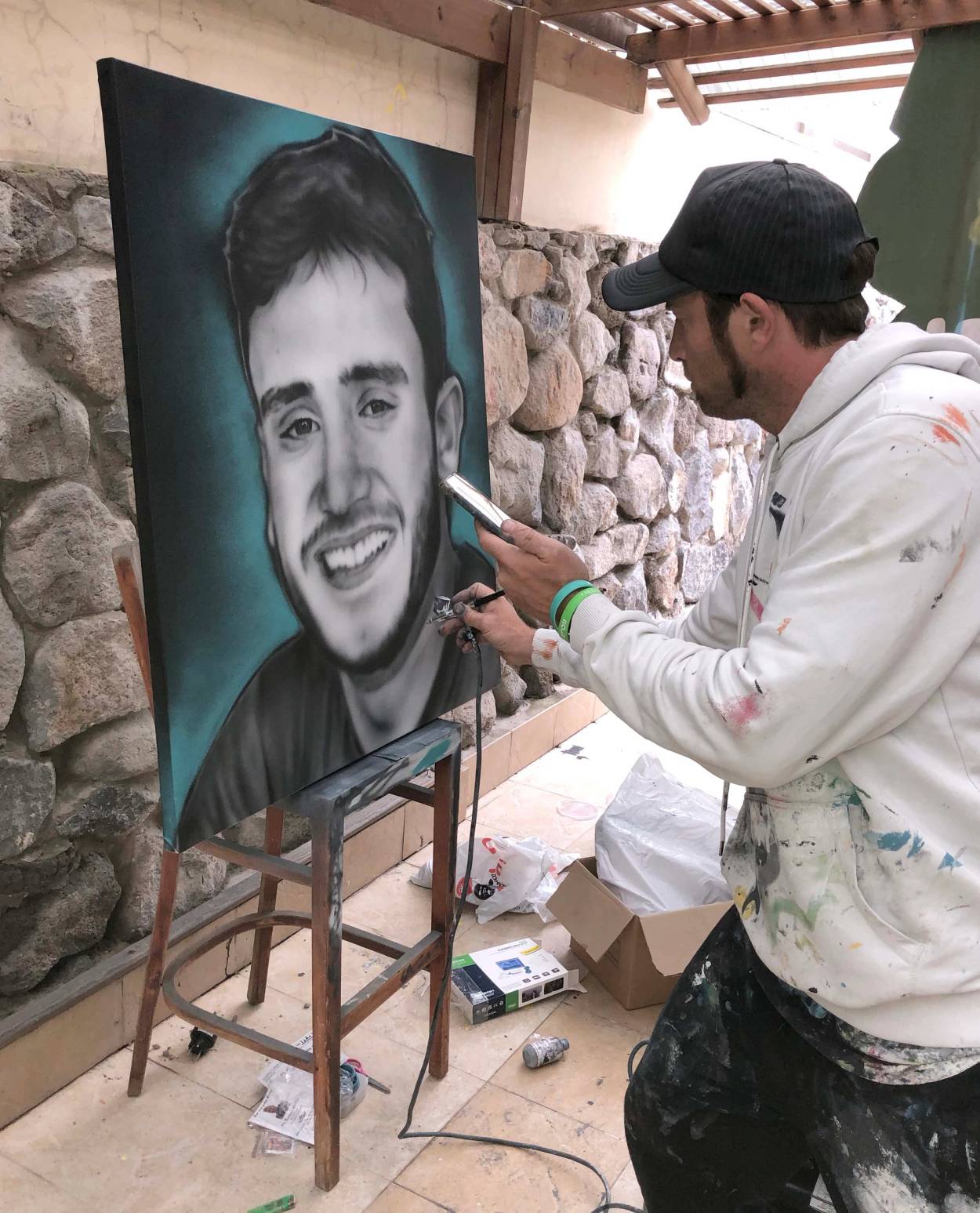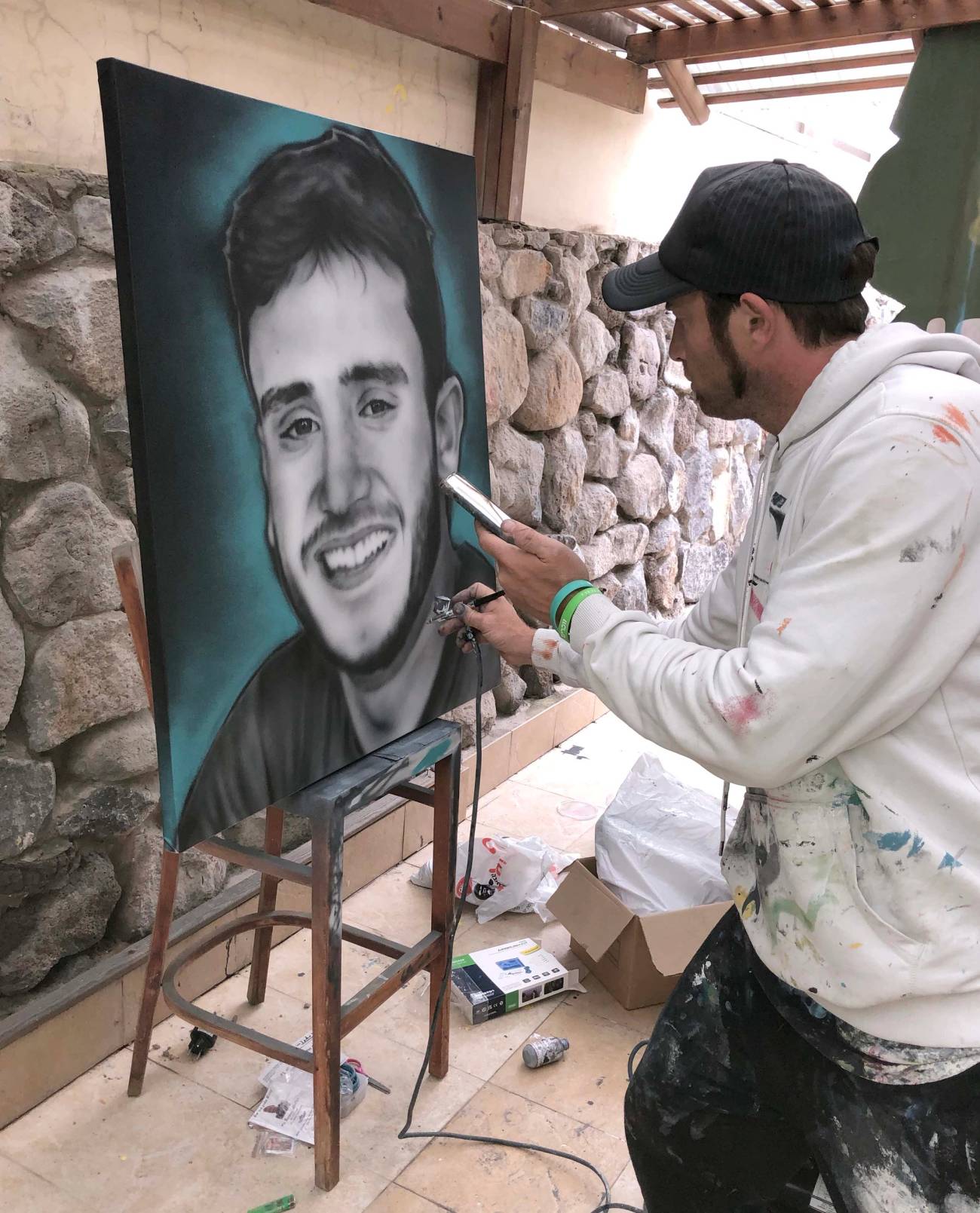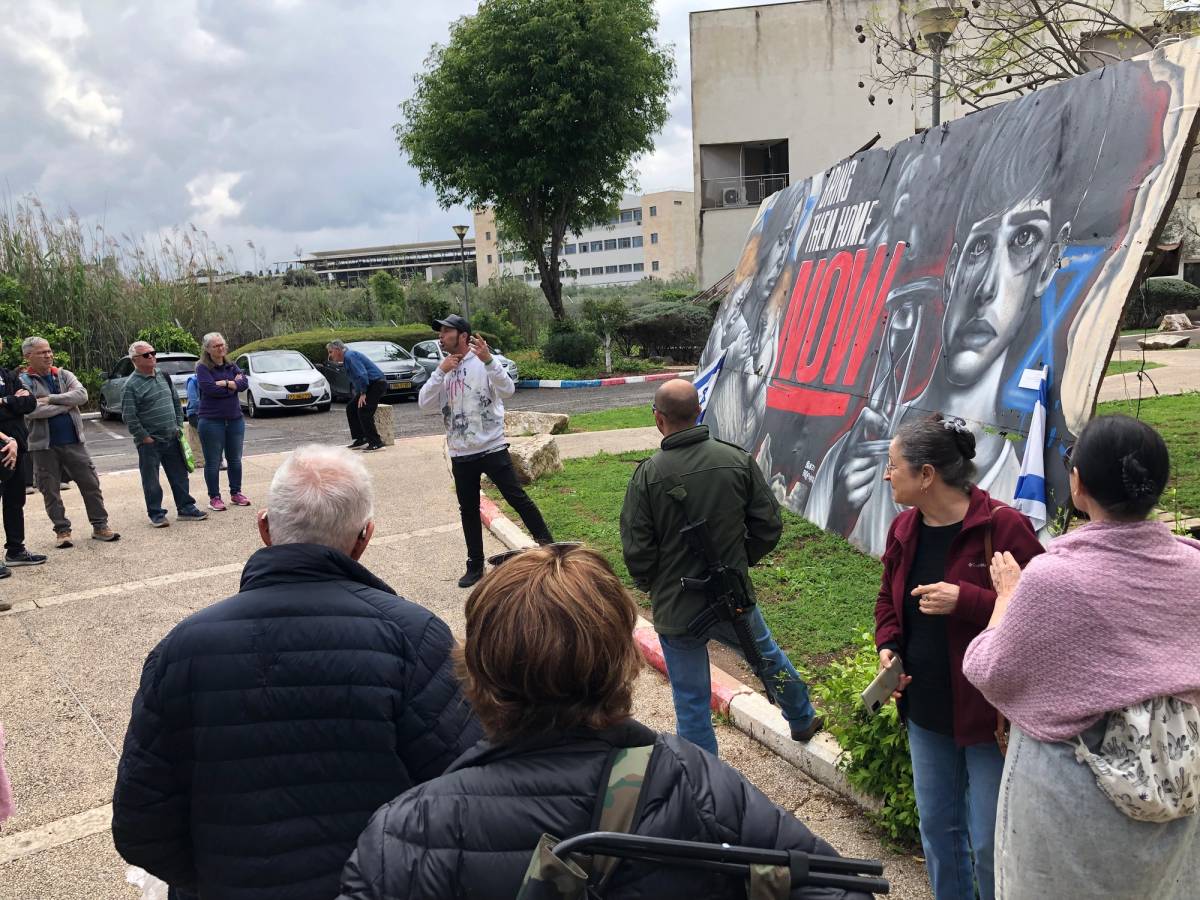Israeli Artists Respond to the Oct. 7 Attacks
Portraits and posters commemorate those killed and kidnapped by Hamas

Hillel Kuttler

Hillel Kuttler

Hillel Kuttler

Hillel Kuttler
Benzi Brofman, an artist in the Jezreel Valley town of Migdal HaEmek, was just about done painting the face of a young man on a 36” x 40” canvas stretched onto a wooden frame that leaned against the top of a barstool.
All that remained were the subject’s eyes, a portrait’s key element. “OK, here we go,” he said, as might a jockey heading into the homestretch.
This was the afternoon of April 10, and Brofman, 40, was working at a makeshift studio on his mother’s back porch. He held the tool of his trade, a metal-tipped hose connected to a humming spray-paint machine. Concentrating intently, Brofman guided the pencillike device near the surface, directing heavier and softer flows of gray paint that hissed onto the canvas to yield darker and lighter shades.
The smartphone Brofman held in his other hand displayed a photograph of the subject that he glanced at every few seconds. Behind him, another phone, secured to a tripod to film the painting process, emitted a loop of sad songs to set the mood.
“I search for moments that won’t become images / This world ceased living,” went one tune, the Israel duo Guy & Yahel’s “Burning Sky,” that played as he worked. “I saw riots, things I don’t want to remember / Children with nowhere to return to.”
The eyes in the portrait took shape. Brofman retreated three steps and said, “Look at him. He has no window shades covering his eyes. You can look into him.”
Brofman drew a heart and the 20-year-old subject’s first name, Reef, on the painting. He took it and drove down the road to Kibbutz Ramat David. There, before 50 or so mourners, Brofman presented the painting to Avi and Sigal Harush at the entrance to their home. The Harushes’ son Reef, a sergeant in the Israel Defense Forces, had been killed in battle in the Gaza Strip town of Khan Yunis four days earlier.
The parents gazed at their son’s likeness. The trio hugged. Many of the onlookers cried.
Reef Harush is one of approximately 60 Israelis whose faces Brofman has painted in recent months. Most commemorate people whom Hamas killed on Oct. 7 and since: soldiers, those attending the Nova music festival at Kibbutz Reim, and residents of the ravaged Gaza-area communities. Some depict those Hamas kidnapped and took to Gaza.
His first subject was Vitali Skipkevitch, 21—an IDF major killed defending Kibbutz Kissufim on Oct. 7—after the soldier’s comrades asked Brofman to memorialize him. That led to further requests, and now Brofman has more work than he can handle, all as a volunteer. A local art supply shop cuts him a break on the costs of materials.
Brofman said he does it to bring comfort to bereaved loved ones and acquaint outsiders with the deceased person.
“Everyone wants people to know who they are,” he said. “Through my work, I enable them to say, ‘Hi, I am _______.’”
The portraits are on display through late April at a college campus in the valley. Each painting is secured to a black post that also holds a paragraph of explanatory text with the person’s name, age, interests, and the circumstances leading to his or her killing. On some posts rest mementos left by loved ones since the exhibition opened: a soccer jersey, a lei, eyeglasses, a backpack, a beach hat, a coffee pot, photographs. A table in the room holds lit memorial candles and personalized pages of some of those depicted. A brief film projected onto a screen along the front wall tells the stories of a handful of the fallen.
That morning, four high school students from Kiryat Tivon left the exhibition and cried. Their classmates inside, nearly all born in Russia, Ukraine, or Belarus, arrived in Israel shortly before and after Oct. 7. Most will remain as immigrants.
This wasn’t their first communal experience of Israel at wartime. The class has visited Hostages Square in Tel Aviv, held assemblies, and released yellow balloons in solidarity with the kidnapped Israelis.
Each outing serves “to connect them to our country, to the history, and to the present situation,” explained Oren Doel, one of their teachers.
“It opens your eyes to see more, to see the lives of other people,” Maksim Gavrilenko, a 10th grader who moved from Moscow to Haifa, said as he left the exhibition. “Everyone has their own stories. You hear their dreams and aspirations. It inspires you to do more.”
Lighting in the room is dim. Each painting is black and white with a burst of color on the edges.
“It’s always been my style,” Brofman explained. “Life is black and white, extremes: alive and dead, healthy and sick, happiness and sadness. What is color? Moments of happiness. Happiness is short moments.”
The exhibition is titled Look Them in the Eyes. I asked Brofman how he selected the theme.
“What are you looking at now? My eyes,” he replied. “The nose doesn’t express emotion. The ears don’t. The mouth: OK, it does, yes. But the eyes are life. I want people to look at their eyes.”
A week later, Zeela Kotler Hadari, the content editor at Tel Aviv’s Institute for Israeli Art, used similar language during a phone conversation about the value of artistically depicting this war’s victims.
“When we see these paintings and see the life in the eyes of these people, it’s like a capsule of life, soul, and spirit,” said Kotler Hadari, who hadn’t known of Brofman. “Drawing is life. Art helps us to process the reality. Art accompanies us in life to understand the reality we’re going through.”
Brofman’s best-known painting is ubiquitous throughout Israel on posters and stickers distributed by the Tel Aviv-based Hostages and Missing Families Forum. It depicts four Israelis whom Hamas kidnapped. A forlorn boy holds an hourglass. A despondent mother comforts a crying infant while a second sobbing youngster clutches her from behind; those children are redheads, representing the brothers Ariel and Kfir Bibas, who were kidnapped at ages 4 and 9 months with their parents. Stars of David touch all four people. At the center, behind the words “Bring Them Home Now,” is a teddy bear.
Art continues to express Israel’s ongoing trauma since Oct. 7. A current exhibition at Tel Aviv’s Anu Museum of the Jewish People displays works of 25 artists in painting, film, and song. Among them is graffiti artist Inbar Heyman, 27, known as Pink for her love of the color, who was kidnapped from the Nova festival and later murdered in Gaza. (Her body remains captive by Hamas.)

Hillel Kuttler
The exhibition “reflects the atrocious times Israeli society is facing,” the museum’s website states. “In times of joy as well as in times of sadness, art has always been a medium for coping and struggling.”
The museum also hosted a project, “Writing the Situation,” for artists to express in words their views of the crisis.
Another exhibition of creative responses to Oct. 7 is being held at the Janco-Dada Museum, in the artists’ colony of Ein Hod, south of Haifa.
“It already seems that the phrase ‘When cannons roar, the muses are silent’ does not reflect the spirit of the times,” explanatory text reads. “There is no stillness in artistic work, even if we haven’t found the words yet.”
The hostage families’ forum itself shifted course artistically to mark the recent half-year point of captivity. It produced new posters that shed much of the gloom through colorful, even whimsical, illustrations of several hostages.
One, in various shades of blue, shows felines enveloping Omer Neutra, a cat lover. Neutra, 22, liked to say that he speaks “the language of cats, and they await his return,” the text reads. Another illustration depicts a shoeless kibbutznik, Alexander Dancyg, 76, seemingly dancing on a strip of grass. “A Renaissance man who loves walking barefoot in the fields and plowing them,” his poster says.
For Brofman, painting pain is outside his comfort zone. He makes his living doing graffiti art for corporate clients, like on the walls of companies’ offices and coffee shops’ interiors. He also enjoys running art projects at birthday parties for children. “I sort of do stand-up for them. They’re kids. They don’t know about [trauma],” he said.
He found a new calling after nearly becoming a Hamas victim.
Brofman attended the Nova festival on Oct. 5 and 6 to paint a triple portrait of Israelis who composed some of the music in the trance genre played that weekend. He planned to stay into the next day, but his mother and wife pressed him to leave.
“It was a gut feeling,” said his mother, Ofira Brofman, who moved to Israel 50 years ago from Moldova. Her parents survived WWII after being sent east by train to Samarkand, Uzbekistan.
“On Thursday night [Oct. 5], I didn’t sleep well. I prayed to God that nothing happens to him,” she said, sitting in her kitchen. While uttering the word “prayed,” she gesticulated, placing her hands together as her fingertips touched her nose. Her voice broke.
She said her fear arose from concern that divisions in Israeli society following the government’s judicial-reform initiative would be exploited by Hamas, then lurking a few hundred yards from her son.
This was the precise way she put the terrorist group’s anticipation of Oct. 7: “The wolves in the area were starving.”
The vivid image would make for an utterly dark artistic depiction.
Hillel Kuttler, a writer and editor, can be reached at [email protected].